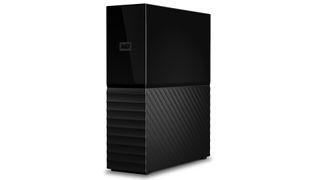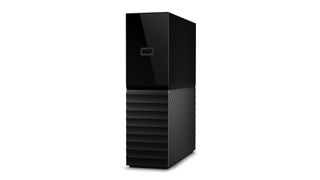TechRadar Verdict
It looks nice, performs well enough and depending on your budget, a huge capacity can be quickly connected. But it needs live sync software to make it more useful, not the WD Discovery suite that it comes with it.
Pros
- +
Affordable
- +
Works with most systems
Cons
- -
Not quick
- -
Lacks any redundancy
- -
Software backup is basic
Why you can trust TechRadar
Those that go looking for a My Book product history will find that at least ten devices have used this moniker, and over the years they’ve been made with USB, Firewire and eSATA connections, and in a myriad of capacities.
They’re mostly designed to be directly connected to a host PC or Mac, providing a place to offline files that are no longer required on the system, or to backup those that are on it.
Most models feature a single 3.5” hard drive mounted in an enclosure that is not made to be user-accessible, although some of the dual drive models have allowed for drive replacements.
Today, we’ll be looking at the latest 2020 incarnation of the Western Digital My Book, that looks remarkably like the 2016 version, but with even great capacities.

Pricing
For head-scratching experiences, the official pricing of the Western Digital My Book takes some beating. Using the https://shop.westerndigital.com/ as a start point depending on what region you are in will determine if you are merely confused, or utterly befuddled.
Where in the USA you can purchase a 3TB model, elsewhere the start point for this range is 4TB, with 6TB, 8TB, 10TB, 12TB and 14TB options.
UK pricing direct from Western Digital for these is £91.99 (4TB), £119.99 (6TB), £172.99 (8TB), £236.99 (10TB), £258.99 (12TB) and £279.99 (14TB).
When converted for the exchange rate those prices seem excessively high compared to the USA pricing of $89.99 (3TB), $109.99 (4TB), $134.99 (6TB), $159.99 (8TB), $209.99 (10TB), $249.99 (12TB) and $279.99 (14TB).
And, in the UK the best value per TB is the 6TB and 14TB models, where stateside the 8TB and 14TB hold those honours.
When we asked Western Digital about these discrepancies and received this reply,
“Prices provided by Western Digital are manufacturer suggested retail prices only and are set according to local market conditions (including tax and exchange rates) and the local competitive landscape”
Our research reveals that online retailers offer substantially better value. We found the 8TB review model could be bought for as little as £167.42 in the UK and $149.99 in the US.

Design
When Western Digital stopped trying to make the My Book series look like actual books, it heralded a vast improvement in aesthetics. And, the two-tone wavy/flat styling still looks good on this latest version.
That said, the designers love of shiny black plastic that comes with clear plastic to be peeled off isn’t without its issues. Once static charged by the removal of the protection, dust is attracted to the My Book like wasps to a family picnic.
Setting up the drive is remarkably simple; it’s a matter of attaching the provided power pack and the USB cable to the computer. This version doesn’t even have a power on/off switch, so the drive becomes active the moment it is connected.
Alongside the USB Type-B Micro connection on the back, and the barrel power socket, the only other external feature of note is a Kensington lock slot, enabling the My Book to be physically secured.
Inside the shiny black case is a WD Red, and 8TB in the review model, and the electronics to enable this SATA mechanism to be interfaced to USB. For those curious, getting the physical drive out of the enclosure probably involves destroying the case. And, we’d only recommend that action if the drive were outside warranty, and you suspected that the USB board or PSU had died, and not the physical drive.
And, if you’ve used the hardware encryption option, extracting the drive might not get your data back anyway.

This unit is meant for desktop use, and therefore it was supplied with a good length USB cable that should reach from the desk to a floor-mounted computer easily.
By default, the My Book comes pre-formatted in exFAT enabling modern PC and Mac computers to read the contents directly, and on the drive is the WD Discovery suite for both platforms ready to install.

Hardware
As we’ve already mentioned the review drive is sold as 8TB, and without dismantling it, we’ve assumed that the drive inside is a WD RED mechanism of the same capacity.
This mechanism is meant for NAS box use and is therefore designed to deliver reliable long-term performance, low power consumption and minimal heat generation. What is wasn’t built to offer was a high performance, but then compared with SSDs physical drives are relative snails to their hare-like solid-state counterparts.
If the computer this is attached only has conventional hard drives, then this won’t be an issue. But, compared to SATA and NVMe SSDs the My Book is slow. And, having an SSD in your system won’t improve the performance of this unit.
What performance can you realistically expect?

Performance and in use
Here’s how the My Book 8TB performed in our suite of benchmark tests:
CrystalDiskMark: 189MBps (read); 179MBps (write)
Atto: 193MBps (read, 256mb); 191MBps (write, 256mb)
AS SSD: 182MBps (seq read); 178MBps (seq write)
AJA: 180MBps (read); 177MBps (write)
We ran several synthetic tests on the My Book 8TB connected to a USB 3.0 port (USB 3.2 Gen 1), and they all pointed towards a plateau at around 190MB/s for reading and 180MB/s for writes.
That’s about a half of what you might expect from a SATA SSD externally connected via USB 3.0, and about a fifth of the best NVMe SSD external drives connected via USB 3.2 Gen 2 ports.
It's quicker than the equivalent Seagate external drives, but neither is quick.
If you have an extensive system to backup to the My Book this would invariably be an out of hours exercise, since small files would reduce the transfer speed further. To make this situation more palatable a backup application that focuses only on files that have changed is required, and the WD Backup tool offers that feature.
But what it won’t do is a live dynamic backup, securing only on an hourly or daily basis.
If you want to secure a system very quickly, the My Book probably isn’t the hardware that you need.
The competition
The primary opposition to the My Book is the Seagate Desktop 8 TB External Hard Drive (STGY8000400), a practically identical concept from another seasoned hard drive maker.
The 8TB version costs just £132.96 ($144.99) on Amazon, making it cheaper than the Western Digital offering in the UK by around £30, and even $5 less than in the US.
But curiously, another choice comes from another line at Western Digital, the Elements Desktop Drive. It’s priced slightly lower, has less attractive styling, and doesn’t come with the software that the My Book line includes.
The price differential is so small that the Elements drive might only be for those who might be buying in bulk, but there are cheaper options available elsewhere.
But the best alternative is the Seagate 8 TB Backup Plus Hub, as it costs just £145 ($154.99), has two USB 3.0 through ports for charging or connecting and comes with backup software.

Final verdict
What’s great about the My Book is that it is remarkably easy to configure and use, being the definition of a plug-in-and-go scenario.
It uses the universally accepted USB 3.0 Type-A connection, most owners will be operationally within minutes of unpacking the device, and ready to use the very ample storage capacity inside.
There are two important issues here that need to be confronted, in our opinion, those of redundancy and securing live data.
Having a single drive storing potentially important data is always something of a gamble since physical mechanisms can, and do, go wrong. Therefore, we wouldn’t recommend putting any files on the My Book that you don’t store elsewhere, in case of failure.
Our other gripe is the lack of a live backup solution in the WD Discovery collection.
Those that work at home, like many people these days, want files they’ve modified to be secured the moment that they’ve closed them, not an hour later. As that increases the probability that data won’t be secured before something unfortunate happens.
The My Book needs that feature adding, bundled with it, and not as a paid extra.
Western Digital could have improved the performance by using SSD caching, but it chose to keep the My Book simple and probably more reliable as a result.
We suspect the next generation of My Book will have this feature and offer USB 3.2 Gen 2 connectivity, but this model works for the broadest possible selection of customers right now, critically.
It might not be anything groundbreaking, but if you need to dump 8TB, or more, of data from your computer and have it still accessible, the Western Digital My Book does this job admirably.
- We've also highlighted the best external drives
Mark is an expert on 3D printers, drones and phones. He also covers storage, including SSDs, NAS drives and portable hard drives. He started writing in 1986 and has contributed to MicroMart, PC Format, 3D World, among others.


